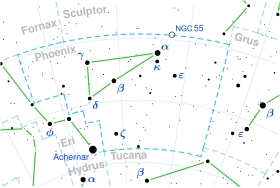HD 12055
HD 12055| 관측 데이터 에폭 J2000 이쿼녹스 J2000 | |
|---|---|
| 별자리 | 피닉스 |
| 우측 상승 | 01h 57m 10.08491s[1] |
| 탈위임 | −47° 23′ 07.0936″[1] |
| 겉보기 크기 (V) | 4.82[2] |
| 특성. | |
| 스펙트럼형 | G6III-IIB |
| U-B색지수 | +0.51[4] |
| B-V색지수 | +0.88[4] |
| 아스트로메트리 | |
| 방사 속도 (Rv) | +13.36±0.22km[1]/s |
| 고유 운동 (μ) | RA: +1987.213마스[1]/yr Dec.: +16.168mas[1]/yr |
| 시차 (π) | 13.1010 ± 0.2295[1] 마스 |
| 거리 | 249 ± 4 리 (76 ± 1 pc) |
| 절대치수 (MV) | 0.42[2] |
| 세부 사항 | |
| 미사 | 2.39[5] M☉ |
| 반지름 | 10.40+0.46 −0.70[1] R☉ |
| 루미도 | 71.1±1.4[1] L☉ |
| 표면 중력 (log g) | 3.04[6] cgs |
| 온도 | 5,196+185 −112[1] K |
| 금속성 [Fe/H] | –0.02[6] 덱스 |
| 회전 속도 (v sin i) | 5.7±1.0km[7]/s |
| 나이 | 1.08[5] Gyr |
| 기타 지정 | |
| 데이터베이스 참조 | |
| 심바드 | 자료 |
HD 12055는 에리다누스와의 동쪽 별자리 경계 부근인 피닉스 남쪽 별자리에 있는 후보 천문학적 이항성계다[9]. 색조가 노란색이며 육안으로는 4.82의 외관상으로 볼 수 있다.[2] 이 시스템은 시차(parallax)를 기준으로 태양으로부터 약 249광년 거리에 위치하며, 방사상 속도 +13 km/s로 더 멀리 떠내려가고 있다.[1]
눈에 보이는 성분은 G6III-IIB의 별 분류를 가진 노화된 거대 항성이다.[3] 중심부의 수소 공급이 고갈되면서, 이 별은 냉각되고 주요 수열에서 벗어났으며, 현재는 태양의 열 번째를[1] 가지고 있다. 태양 질량의 2.4배인[5] 약 10억년[5] 전으로, 6km/s의 예상 회전 속도로 회전하고 있다.[7] 이 별은 유효온도 5,196 K로 광권으로부터 태양의 71배의 광도를 발산하고 있다.[1]
이 시스템은 이들 좌표에서 나오는 X선 방출의 가장 가능성이 높은 원천이다.[10]
참조
- ^ a b c d e f g h i j k l Brown, A. G. A.; et al. (Gaia collaboration) (August 2018). "Gaia Data Release 2: Summary of the contents and survey properties". Astronomy & Astrophysics. 616. A1. arXiv:1804.09365. Bibcode:2018A&A...616A...1G. doi:10.1051/0004-6361/201833051.이 소스에 대한 가이아 DR2 기록 VizieR.
- ^ a b c Anderson, E.; Francis, Ch. (2012). "XHIP: An extended hipparcos compilation". Astronomy Letters. 38 (5): 331. arXiv:1108.4971. Bibcode:2012AstL...38..331A. doi:10.1134/S1063773712050015. S2CID 119257644. Vizier 카탈로그 항목
- ^ a b Keenan, Philip C.; McNeil, Raymond C. (1989). "The Perkins catalog of revised MK types for the cooler stars". Astrophysical Journal Supplement Series. 71: 245. Bibcode:1989ApJS...71..245K. doi:10.1086/191373.
- ^ a b Mallama, A. (2014). "Sloan Magnitudes for the Brightest Stars". The Journal of the American Association of Variable Star Observers. 42: 443. Bibcode:2014JAVSO..42..443M.Vizier 카탈로그 항목
- ^ a b c d Luck, R. Earle (2015), "Abundances in the Local Region. I. G and K Giants", The Astronomical Journal, 150 (3): 88, arXiv:1507.01466, Bibcode:2015AJ....150...88L, doi:10.1088/0004-6256/150/3/88, S2CID 118505114.
- ^ a b Alves, S.; et al. (April 2015). "Determination of the spectroscopic stellar parameters for 257 field giant stars". Monthly Notices of the Royal Astronomical Society. 448 (3): 2749–2765. arXiv:1503.02556. Bibcode:2015MNRAS.448.2749A. doi:10.1093/mnras/stv189.
- ^ a b De Medeiros, J. R.; et al. (2014). "A catalog of rotational and radial velocities for evolved stars". Astronomy & Astrophysics. 561: A126. arXiv:1312.3474. Bibcode:2014A&A...561A.126D. doi:10.1051/0004-6361/201220762. S2CID 54046583. Vizier 카탈로그 항목
- ^ "HD 12055". SIMBAD. Centre de données astronomiques de Strasbourg. Retrieved 2019-11-13.
- ^ Eggleton, P. P.; Tokovinin, A. A. (September 2008). "A catalogue of multiplicity among bright stellar systems". Monthly Notices of the Royal Astronomical Society. 389 (2): 869–879. arXiv:0806.2878. Bibcode:2008MNRAS.389..869E. doi:10.1111/j.1365-2966.2008.13596.x. S2CID 14878976.
- ^ Haakonsen, Christian Bernt; Rutledge, Robert E. (September 2009). "XID II: Statistical Cross-Association of ROSAT Bright Source Catalog X-ray Sources with 2MASS Point Source Catalog Near-Infrared Sources". The Astrophysical Journal Supplement. 184 (1): 138–151. arXiv:0910.3229. Bibcode:2009ApJS..184..138H. doi:10.1088/0067-0049/184/1/138. S2CID 119267456.



